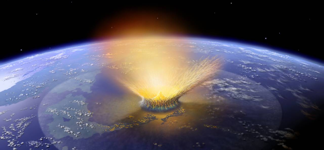
Artist rendering of an asteroid impacting Earth (NASA)
Scientists say they may have found a link between a dramatic climate shift nearly 13,000 years ago and an asteroid or comet that struck the Canadian province of Quebec.
Researchers at Dartmouth College say the comet/asteroid strike took place at the beginning of a global cooling event known as the Younger Dryas stadial or the Big Freeze.
It was an abrupt, geologically brief period of colder and dryer climatic conditions that lasted about 1,300 years, and had far-reaching effects on both humans and animals.
Big animals, such as mastodons, camels, giant ground sloths, and saber-toothed cats all vanished from North America during this cool period.
The humans who lived in North America at the time, known as Clovis people, normally hunted the large animals, but after this extinction they set aside their heavy hunting weapons and adopt a hunter-gatherer lifestyle, living off a diet of roots, berries, and smaller game.

Paleo-Indians (includes Clovis People), shown hunting a glyptodont (armadillo ancestor ), were the first humans to enter and inhabit the Americas.(Heinrich Harder via Wikimedia Commons)
“The Younger Dryas cooling is a very intriguing event that impacted human history in a profound manner,” said Mukul Sharma, one of the study authors and a professor in Dartmouth’s Department of Earth Sciences. “Environmental stresses may also have caused Natufians (a culture that existed between 13,000 and 9,000 BC) in the Near East to settle down for the first time and pursue agriculture.”
While the environmental changes brought on by the Younger Dryas haven’t been disputed, the causes of it have been.
Scientists have long thought the Younger Dryas period was caused by a surge of meltwater from the North American ice sheet from the last glacial period.
According to this theory, a great amount of fresh water from melted ice collected behind an ice dam, which suddenly burst, dumping huge quantities of freshwater into the Atlantic Ocean. The sudden water surge was thought to have shut down the ocean currents that usually move ocean water from the tropics northward. The lack of the usual northbound stream of warmer water then left the climate cold and dry throughout the Younger Dryas period.
Sharma said that while his team’s research shows conclusive proof that an asteroid/comet impacted over the North American Ice Sheet around the beginning of the Younger Dryas period, further investigation will need to determine whether the cosmic event is linked to the Big Freeze.
The researchers found evidence of a connection in droplets of solidified molten rock thrown off from a celestial object during impact. The spherules were collected from boundary layers of sediment from the beginning of the Big Freeze at sites in Pennsylvania and New Jersey.

The high temperatures of the meteorite impact 12,900 years ago produced mm-sized spherules of melted glass with the mullite and corundum crystal structure shown here. (Mukul Sharma)
There is a 4-kilometer-wide impact crater in Quebec, known as the Corossol crater, where researchers believe a meteor or comet hit. The New Jersey and Pennsylvania spherules are identical to rock found in southern Quebec, but geochemical and mineralogical research indicates they are not a perfect match.
“What is exciting in our paper is that we have for the first time narrowed down the region where a Younger Dryas impact did take place, even though we have not yet found its crater,” Sharma said in a press release.
Sharma also pointed out that the extensive environmental changes of the Younger Dryas might be the result of not just one but multiple concurrent asteroid/comet impacts.
The study, funded by the National Science Foundation, will be published in the Proceedings of the National Academy of Sciences (PNAS).





















Comments are closed.